
"Thinking on Your Feet: The Art of Asking the Right Questions" is a book by M. Neil Browne.
Chapter 2 Is Asking the Right Questions Book recommended for reading?The book "Asking the Right Questions" is a guide to critical thinking. It teaches readers how to improve their thinking and decision-making skills by asking well-crafted questions. The author emphasizes the importance of questioning assumptions, evaluating evidence, and avoiding common biases. The book provides practical examples and exercises to help readers apply critical thinking techniques in various contexts, such as personal life, business, and politics.
The book has been generally well-received and widely used in academic settings as a resource for teaching critical thinking skills. It offers valuable insights and strategies that can be applied in everyday life. However, it is worth noting that the book primarily focuses on critical thinking concepts rather than providing in-depth analysis on specific subjects.
Ultimately, whether the book is considered "good" or not depends on individual preferences and needs. If you are interested in improving your critical thinking abilities and applying them to a range of situations, "Asking the Right Questions" could be a valuable resource.
Chapter 3 Asking the Right Questions Book SummaryThe book "Asking the Right Questions" by M. Neil Browne is a guide for improving critical thinking skills and becoming a better questioner. It argues that our success in life depends on our ability to ask the right questions, rather than simply finding the right answers. The book provides practical tips and techniques for asking effective questions, challenging assumptions, and evaluating evidence.
The author emphasizes the importance of asking open-ended, probing questions that encourage critical thinking and promote deeper understanding. He suggests that effective questioning can lead to better decision-making, problem-solving, and communication.
The book is divided into several chapters, each focusing on a different aspect of questioning. It covers topics such as identifying issues, evaluating evidence, recognizing assumptions, avoiding fallacies, and analyzing sources. It also includes numerous real-life examples and exercises to practice the concepts discussed.
Overall, "Asking the Right Questions" aims to help readers develop their critical thinking skills and become more discerning in their thinking and decision-making. It emphasizes the importance of questioning our own beliefs and assumptions and encourages a more thoughtful, logical, and evidence-based approach to problem-solving.
Chapter 4 Meet the Writer of Asking the Right Questions BookThe book "Asking the Right Questions: A Guide to Critical Thinking" is written by M. Neil Browne and Stuart M. Keeley. The first edition of the book was released in 1987, and it has since undergone various revisions and updates.
Apart from "Asking the Right Questions," M. Neil Browne has also written other books, including "Thinking on Your Feet in Negotiations" and "The Essence of Supply Chain Management." However, the best edition of "Asking the Right Questions" is subjective and depends on individual preferences and requirements. It is recommended to read the latest edition available, as it would contain the most recent revisions and updates.
Chapter 5 Asking the Right Questions Book Meaning & Theme Asking the Right Questions Book MeaningAsking the Right Questions: A Guide to Critical Thinking is a book written by M. Neil Browne that aims to help readers develop their critical thinking skills by learning how to ask effective questions. The book emphasizes the importance of asking the right questions in order to gather accurate information, think critically, and make informed decisions.
The meaning of the book lies in its ability to teach readers how to avoid common pitfalls in reasoning and decision-making by asking smart, probing questions. It provides practical strategies and techniques to improve critical thinking, including identifying biases and assumptions, evaluating evidence, and forming well-reasoned arguments.
The overall message of the book is that asking the right questions is essential for making sound judgments and finding reliable information in a world full of misinformation and biases. It encourages readers to challenge their own beliefs and opinions, and to seek a deeper understanding of complex issues by questioning and analyzing various perspectives.
By mastering the art of asking the right questions, readers can become more intellectually engaged, open-minded, and effective problem solvers. The book serves as a guide to developing critical thinking skills that can be applied in various aspects of life, from personal decision-making to professional endeavors.
Asking the Right Questions Book ThemeThe theme of the book "Asking the Right Questions" by M. Neil Browne is critical thinking. The book focuses on the importance of asking well-constructed questions in order to analyze information critically and make informed decisions. It emphasizes the need to question assumptions, evaluate evidence, and consider alternative perspectives before forming conclusions or taking action. The book provides a framework and strategies for developing effective questioning skills and applying them to various contexts, including personal life, education, and the workplace. Overall, the theme revolves around the idea that asking the right questions is essential for developing critical thinking skills and making sound judgments.
Chapter 6 Various Alternate Resources- Goodreads: This popular website for book lovers offers reviews, ratings, and discussions about "Asking the Right Questions" by M. Neil Browne.
- Amazon: As one of the largest online book retailers, Amazon provides details about the book, customer reviews, and the option to purchase in various formats (e.g., Kindle, paperback).
- Barnes & Noble: Another major bookseller, Barnes & Noble offers information on "Asking the Right Questions" along with customer reviews and purchasing options.
- Google Books: Users can access previews, reviews, and ratings for "Asking the Right Questions" on this platform, as well as find links to where the book can be purchased.
- YouTube: The popular video-sharing website may feature book review channels, author interviews, or summaries related to "Asking the Right Questions" that can provide valuable insights.
- Goodreads Groups: Within Goodreads, specific groups may be dedicated to discussing books like "Asking the Right Questions," allowing users to engage in conversations with fellow readers.
- LinkedIn: Professional networking platforms like LinkedIn may include discussions or articles related to "Asking the Right Questions," especially within groups focused on personal development or critical thinking.
- Medium: This online publishing platform often features articles, reviews, or analysis pieces related to various books, including "Asking the Right Questions."
- Twitter: Users can follow hashtags like #AskingTheRightQuestions or #MNeilBrowne to find relevant discussions, quotes, or recommendations related to the book on this social media platform.
- Podcasts: Searching podcast platforms such as Apple Podcasts or Spotify for episodes featuring "Asking the Right Questions" can provide audio discussions, interviews, or chapter summaries related to the book.
Asking the Right Questions Book quotes as follows:
- "The right question can be more powerful than the right answer."
- "Questions push boundaries, challenge assumptions, and unlock new possibilities."
- "Asking the right questions is not about finding the 'correct' answer, but about discovering the best way forward."
- "The quality of our questions determines the quality of our solutions."
- "Don't focus on having all the answers, focus on asking the right questions."
- "The more open and curious we are in our questioning, the more we learn and grow."
- "Questioning is an art that requires patience, empathy, and the willingness to challenge our own beliefs."
- "Don't be afraid to ask tough questions; they often lead to breakthrough insights."
- "Great questions ignite conversations, stimulate creativity, and foster collaboration."
- "Questioning is an essential skill for critical thinking and decision-making; without it, we risk stagnation and missed opportunities."
Title: Book Recommendations After Reading "Asking the Right Questions"
- "Thinking, Fast and Slow" by Daniel Kahneman
This book offers insightful explanations about how our minds work and how we make decisions. It delves into the different thought processes we employ and the biases that can affect our thinking. Kahneman's research, combined with his engaging writing style, makes it an excellent choice for readers seeking to deepen their understanding of critical thinking.
- "The Art of Thinking Clearly" by Rolf Dobelli
In this book, Rolf Dobelli explores the common cognitive biases that lead us astray and hinder our decision-making abilities. With clear and concise explanations, he offers practical advice on how to recognize and overcome these biases, enabling readers to cultivate a more critical mindset. "The Art of Thinking Clearly" is a valuable companion to enhance the skills learned in "Asking the Right Questions."
- "Weapons of Math Destruction" by Cathy O'Neil
Cathy O'Neil's book sheds light on the dangers of blind reliance on algorithms and data-driven decision-making. By examining their impact on various aspects of society, she highlights the importance of questioning the assumptions and biases embedded within these systems. "Weapons of Math Destruction" encourages readers to look beyond surface-level information, further strengthening their ability to analyze and evaluate arguments.
- "The Demon-Haunted World: Science as a Candle in the Dark" by Carl Sagan
In this captivating book, renowned scientist Carl Sagan argues for the critical role of scientific thinking in our society. He emphasizes the importance of skepticism, the scientific method, and the ability to distinguish between credible evidence and mere speculation. "The Demon-Haunted World" serves as a reminder of the value of logical reasoning and the need to question claims that lack substantive support.
- "Nudge: Improving Decisions About Health, Wealth, and Happiness" by Richard H. Thaler and Cass R. Sunstein
By exploring the concept of "nudging," Thaler and Sunstein investigate ways in which individuals can be guided toward making better choices without restricting their freedom. Drawing upon behavioral economics and psychology, the authors provide valuable insights on decision-making and suggest strategies for improving our ability to make rational choices. "Nudge" complements the critical thinking skills developed in "Asking the Right Questions."
These five book recommendations cover a wide range of topics related to critical thinking, decision-making, and cognitive biases. They provide valuable insights and practical advice to further enhance readers' ability to analyze arguments, evaluate evidence, and approach information with a critical mindset.
More Episodes
 2024-04-15
2024-04-15
 12
12
 2024-04-14
2024-04-14
 12
12
 2024-04-14
2024-04-14
 12
12
 2024-04-13
2024-04-13
 22
22
 2024-04-12
2024-04-12
 14
14
 2024-04-12
2024-04-12
 13
13
 2024-04-11
2024-04-11
 15
15
 2024-04-10
2024-04-10
 16
16
 2024-04-08
2024-04-08
 20
20
 2024-04-06
2024-04-06
 13
13
Create your
podcast in
minutes
- Full-featured podcast site
- Unlimited storage and bandwidth
- Comprehensive podcast stats
- Distribute to Apple Podcasts, Spotify, and more
- Make money with your podcast
It is Free
- Privacy Policy
- Cookie Policy
- Terms of Use
- Consent Preferences
- Copyright © 2015-2024 Podbean.com






